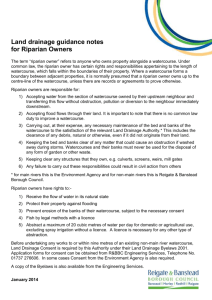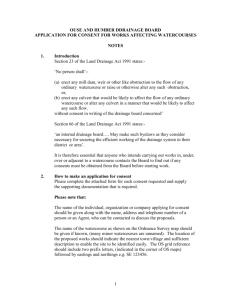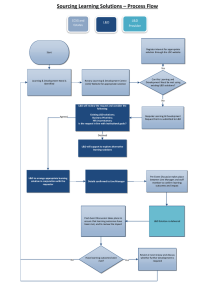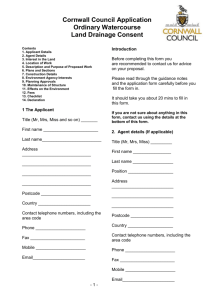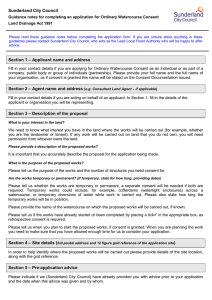Guidance notes for ordinary watercourses land drainage consent
advertisement
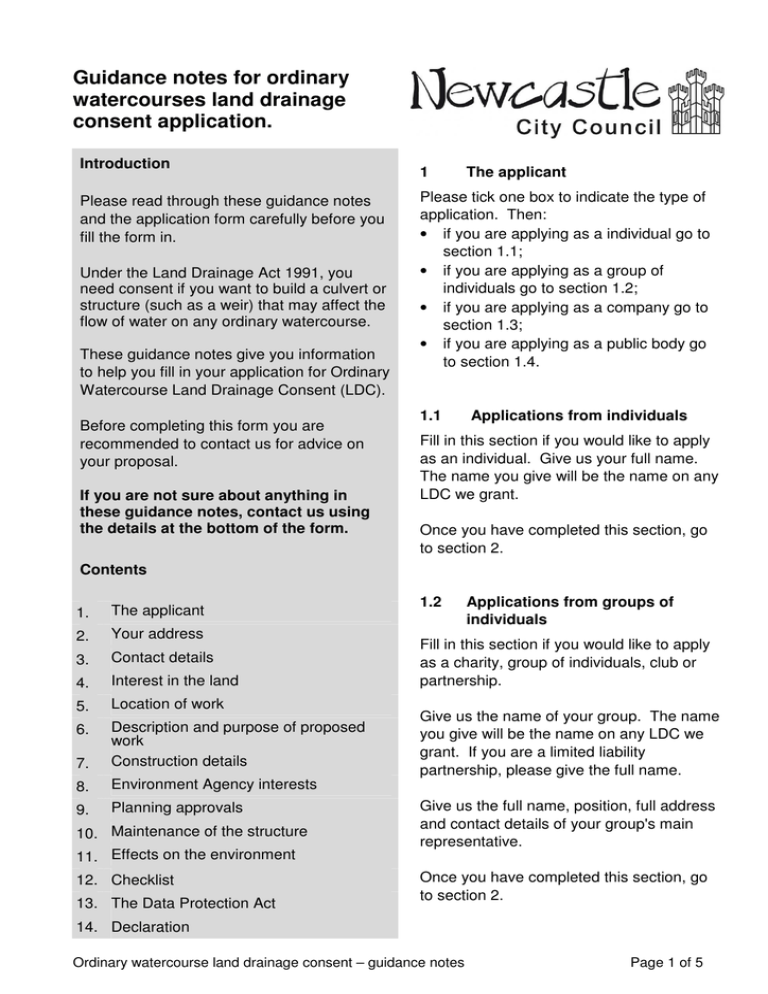
Guidance notes for ordinary watercourses land drainage consent application. Introduction Please read through these guidance notes and the application form carefully before you fill the form in. Under the Land Drainage Act 1991, you need consent if you want to build a culvert or structure (such as a weir) that may affect the flow of water on any ordinary watercourse. These guidance notes give you information to help you fill in your application for Ordinary Watercourse Land Drainage Consent (LDC). Before completing this form you are recommended to contact us for advice on your proposal. If you are not sure about anything in these guidance notes, contact us using the details at the bottom of the form. 1 The applicant Please tick one box to indicate the type of application. Then: • if you are applying as a individual go to section 1.1; • if you are applying as a group of individuals go to section 1.2; • if you are applying as a company go to section 1.3; • if you are applying as a public body go to section 1.4. 1.1 Applications from individuals Fill in this section if you would like to apply as an individual. Give us your full name. The name you give will be the name on any LDC we grant. Once you have completed this section, go to section 2. Contents 1. The applicant 2. Your address 3. Contact details 4. Interest in the land 5. Location of work 6. 7. Description and purpose of proposed work Construction details 8. Environment Agency interests 9. Planning approvals 10. Maintenance of the structure 11. Effects on the environment 12. Checklist 13. The Data Protection Act 1.2 Applications from groups of individuals Fill in this section if you would like to apply as a charity, group of individuals, club or partnership. Give us the name of your group. The name you give will be the name on any LDC we grant. If you are a limited liability partnership, please give the full name. Give us the full name, position, full address and contact details of your group's main representative. Once you have completed this section, go to section 2. 14. Declaration Ordinary watercourse land drainage consent – guidance notes Page 1 of 5 1.3 Applications from companies Fill in this section if you would like to apply for Land Drainage Act consent (LDC) as a registered company. To apply as a company, you must be a registered company formally registered with Companies House. You must give us your company name, as registered with Companies House, your company registration number, and the full name of the company director, and his/her official position. Any LDC you receive will be in the company name registered with Companies House. If you are applying as an individual, a group of individuals or a public body, go to section 2.2 and give the address of your main office in the UK. We will not be able to process your application if you do not give us a UK address. 3 Contact details Once you have completed this section, go to section 2. All applicants complete this section. You must tell us who we should contact about your application for LDC. You can nominate someone other than the person named on the LDC (for example, a consultant or agent). You must give us your or the relevant person's full name, address and contact details. 1.4 4 Applications from public bodies Fill in this section if you would like to apply as a public body such as a local authority or an NHS trust. Please give us the full name of the public body. The name you give will be the name on any LDC we grant. You should also specify what type of public body you are. Once you have completed this section, go to section 2. 2 Your address All applicants must complete this section. You must give us your full UK address. The address you give here will be the address your LDC will be registered to and will be shown on any LDC we grant. If you are applying as a company, complete section 2.1. Give your office address registered with Companies House. If this address is outside the UK, give the address of your main UK office in section 2.2. We will not be able to process your application if you do not give us a UK address. Interest in the land We must know what interest you have in the land where the works will be carried out (for example, whether you are the land owner or tenant). If any work will be carried out on land that you do not own, you will require permission from the land owner. It is your responsibility to obtain this permission from whoever owns the land. 5 Location of the proposed works We must be able to identify where the proposed works will be carried out. Please give details of: • the National Grid Reference (twelve figures); • the location of the site; and • the name of the watercourse. 6 Description & purpose of the proposed works It is important that you accurately describe the proposals for the application being made. Please also tell us the purpose of the works. Ordinary watercourse land drainage consent – guidance notes Page 2 of 5 To consider your proposals we require detailed plans and drawings showing the proposed works, including levels above Ordnance Datum where applicable. • Where possible, you should provide digital copies of all relevant plans and drawings either by e-mail or on CD. However, paper copies must be available on request. The drawings must be no larger than A0 size, and must include: • • location plan o this must be at an appropriate scale and be based on an Ordnance Survey map; o it must clearly show the general location of the site where the proposed work will be carried out and include general features and street names; o it must also identify the watercourse or other bodies of water in the surrounding area. site plan (general arrangement) o the plan must show the existing site, including all watercourses; o the plan must show your proposals; o the plan must show the position of any structures which may influence local river hydraulics, including bridges, pipes & ducts, ways of crossing the watercourse, culverts & screens, embankments, walls, outfalls etc.; o the plan must show existing fish passes or structures intended to allow fish to pass upstream and downstream; o the plan must be drawn to an appropriate scale, which must be clearly stated. detailed drawings o the drawings must show the materials to be used for any structures; o the drawings must show the location of any proposed service pipes or cables which may affect the future maintenance of the watercourse; o the drawings must show details of any tree, shrub, hedgerow, pond or wetland area that may be affected by the proposed works; o the drawings must show details of any planting or seeding; o the drawings must show dams and weirs; o the drawings must show the extent of any water impounded (held back) under normal and flood conditions; o the drawings must show any land drains to be affected. 7 Construction details Separate consents are required for the permanent works and any temporary works that do not form part of the permanent works. Temporary works may include, for example, cofferdams (watertight enclosures) across a watercourse, or temporary diversions of water while work is carried out. For any temporary work, we must know how you are proposing to carry out the work. You must send us a method statement that includes details of the specific measures you plan to take to keep disruption to a minimum and reduce any unwanted effects while the work is being carried out. We must know when you are proposing to carry out the work and how long it will take. When you are planning the work you must ensure that you have allowed enough time for us to consider your application. Ordinary watercourse land drainage consent – guidance notes Page 3 of 5 8 Environment Agency interests Please indicate as appropriate. If you answer yes to any of the questions, you may require an extra license or consent from the Environment Agency before you start work. Please contact the Environment Agency on 03708 506 506. You should make sure that you have enough time to arrange all approvals before you start work. If you do not, this may delay your works. 9 Planning approvals Please provide details of any planning permissions you may have or are applying for that relate to this proposal. 10 Maintaining the structure We must know who will be responsible for maintenance during construction work and when the works have been completed. 11 Effects on the environment We have a legal duty to protect and improve the environment, so we must consider the environmental effects of your proposal. You may need to carry out an environmental appraisal to assess the effects of your work. You should contact us before you send us your application so that we can give you advice on this. If you do not, approval of you your application may be delayed. The environmental appraisal should identify all likely effects on the environment. You should consider the direct and indirect effects the work has on sites and features of interest and species of particular value. Include any specific measures you plan to keep disruption to a minimum and reduce any unwanted effects while the work is being carried out. Set out any opportunities for you to improve the environmental value of the site. This may include creating water features, planting trees & shrubs that would normally grow at the site, providing bird nesting boxes or creating sustainable places for wildlife to live. If as part of a planning permission the Environment Agency has asked for an environmental appraisal, you must send it to us with all the supporting documents. If your site falls within, is next to or is linked to a nature conservation site, contact us as soon as possible to discuss your proposals before you send us your application. Under the European Habitats Regulations, we must make sure that LDC does not have a direct or indirect negative effect on any site specified in the regulations, including: • sites of special scientific interest; • designated special areas of conservation; • special protection areas; • listed Ramsar sites (wetlands); and • scheduled ancient monuments. Under the Habitats Regulations, we must consult Natural England. You may wish to contact them yourself to speed the application process. 12 Checklist Indicate the relevant documents in this section so that we know what you are sending. 13 The Data Protection Act 1998 This section details how we may process the information you provide in your application for ordinary watercourse land drainage consent. Ordinary watercourse land drainage consent – guidance notes Page 4 of 5 14 Declaration By signing this section you are declaring that the information you have provided, including the map and any supporting documents, is true. We will not accept any application that is not signed. If you are applying as a company which has trustees, all trustees must sign the declaration. If you are applying as a limited company, a company secretary or a director must sign the declaration. Charge The cost of an Ordinary Watercourse permit is £50.00, this must be paid before consent is provided Next steps Please return a signed paper copy of the completed application form together with any supporting documents to the address below. Digital copies of the completed application form (without a signature) and digital copies of the supporting documents should be sent to the email address below. We will contact you on receipt of the paperwork regarding the fee. If you need help filling in this form, contact the person who sent it to you, or contact us at the address shown below. Address: Newcastle City Council Flood Risk Management, 5th Floor, Civic Centre Barras Bridge, Newcastle Upon Tyne, NE1 8QH Telephone: 0191 2116848 Email: floodmangement@newcastle.gov.uk Website: www.newcastle.gov.uk Please tell us if you have any communication needs such as needing information in a different language or alternative format (for example, in large print, Braille and so on). Ordinary watercourse land drainage consent – guidance notes Page 5 of 5
